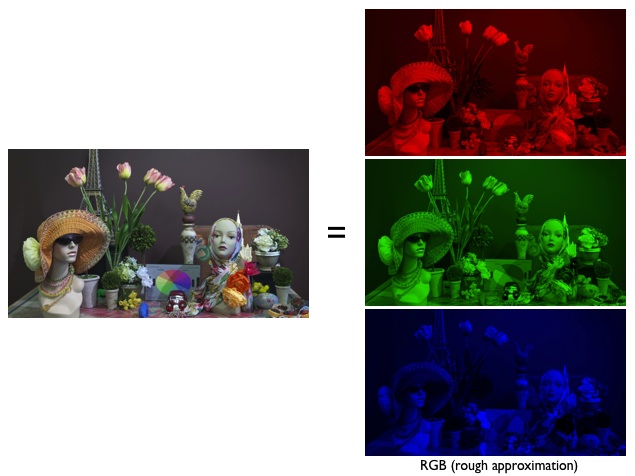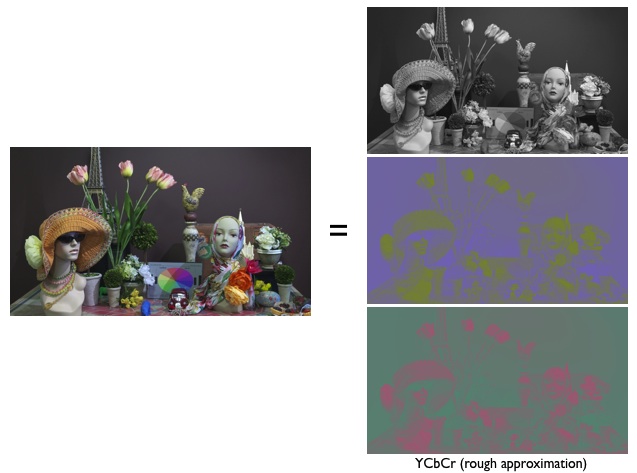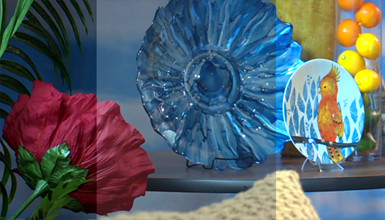 First, I'll talk about different color models in the HD world, which are often shown as 'Y Cb Cr', 'Y Pb Pr' or 'RGB'. Then I'll cover color sub-sampling, which is most often described by a combination of numbers such as 4:2:2 or 4:2:0. These two terms are closely associated with one another, but have very different implications. Let's start by looking at two HD formats, each with a different color space and sampling. On the new PMW-F3 camera, you can record internally in the XDCAM EX format, but also output an S-Log RGB signal over Dual-Link or 3G SDI. More specifically in 1080 24p,
First, I'll talk about different color models in the HD world, which are often shown as 'Y Cb Cr', 'Y Pb Pr' or 'RGB'. Then I'll cover color sub-sampling, which is most often described by a combination of numbers such as 4:2:2 or 4:2:0. These two terms are closely associated with one another, but have very different implications. Let's start by looking at two HD formats, each with a different color space and sampling. On the new PMW-F3 camera, you can record internally in the XDCAM EX format, but also output an S-Log RGB signal over Dual-Link or 3G SDI. More specifically in 1080 24p,
XDCAM EX = 8-bit YCbCr 4:2:0 1920 x 1080 23.98p recording (35 Mb/s recorded)
S-Log RGB = 10-bit RGB 4:4:4 1920 x 1080 23.98Psf (Uncompressed)
The text in red describes the color model, and the text in blue describes the color sub-sampling. Here is a short description of both.
Color Model
A color model is a system for representing color as a series of numbers, three numbers in the case of a RGB or YCbCr. Combine a color model with a color gamut, and you get what is called the color space. Gamut and color space are topics for future blogs, but it's good to understand the relationship.
RGB - In the RGB color model, each pixel of the image has three chroma values (red, green and blue) and each of those color values has luminance (brightness) information as well. So in the RGB model, each frame is made up of three different color images. This becomes very useful in color correction, because each frame is essentially three different images put together.
YCbCr (YPbPr) - YCbCr describes a digital signal and YPbPr describes an analog signal, but they share the same basic model. Each pixel of the image contains luminance Y, blue-difference chroma Cb, and red-difference chroma information Cr. In the YCbCr model, each frame is made up of a luminance only (black & white) image, and two chroma components. Green information comes from a combination of the chroma and luminance data. YCbCr was created in order to reduce the bandwidth of the video signal by removing the redundant luminance signals in RGB (each having their own luminance value). This also enables the reduction of color information without effecting the actual resolution of the image. This process is called Color Sub-sampling.
Color Sub-Sampling
Color Sub-sampling is a method of reducing color resolution without effecting the overall resolution of the image. By reducing color information, the bit rate of the video stream can also be reduced. In the YCbCr color model, this is easily achieved because the luminance (Y) part of the image is separate from the Chroma (C) parts of the image. Looking at the diagram above you can see that the luminance signal is essentially a black and white image; our eyes are better at seeing brightness, so the Y signal is generally kept at full resolution. However, if we reduce the resolution of the color images (Cb, Cr), we have a hard time telling the difference. We often see those numbers associated with a compression like '4:2:2' or '4:2:0'. They refer to the method and amount of Color Sub-sampling. Just for this blog, we will call them a sampling triplet. The numbers break down quite simply: just imagine a simple 4 pixel wide by 2 pixel tall box at the center of a 4:4:4 sampled image: 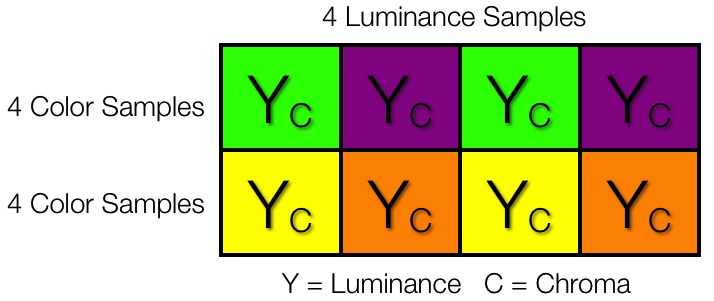 1) The first value in the sampling triplet represents the luminance (Y) sampling in the image across both lines. As you can see in the image above, we have Y values for all four pixels on both lines. Therefore, we have full luminance resolution. 2) The second value of the sampling triplet represents the amount of chroma information in the first line of the box. In the image, above we have four chroma samples (C), so we have full chroma resolution on that line. 2) The third value of the sampling triplet represents the amount of chroma information in the second line of the box. In the image above, we have four chroma samples (C), so we have full chroma resolution on that line. Thus, the image above could be called 4:4:4, with full color and luminance information. When we start to reduce that information, things get a bit more tricky. Let's look at 4:2:2 -
1) The first value in the sampling triplet represents the luminance (Y) sampling in the image across both lines. As you can see in the image above, we have Y values for all four pixels on both lines. Therefore, we have full luminance resolution. 2) The second value of the sampling triplet represents the amount of chroma information in the first line of the box. In the image, above we have four chroma samples (C), so we have full chroma resolution on that line. 2) The third value of the sampling triplet represents the amount of chroma information in the second line of the box. In the image above, we have four chroma samples (C), so we have full chroma resolution on that line. Thus, the image above could be called 4:4:4, with full color and luminance information. When we start to reduce that information, things get a bit more tricky. Let's look at 4:2:2 - 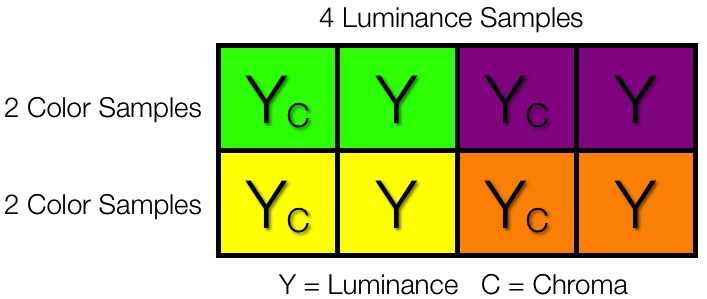
As you can see, we still have full luminance information (the first '4'), but we have less chroma information, two on the first line and two on the second. So we have effectively cut our color resolution in half on both lines. This sounds bad, but 4:2:2 does very well for almost all situations. The chroma information that is removed has been averaged into the other value to keep the image accurate. What about 4:1:1 - 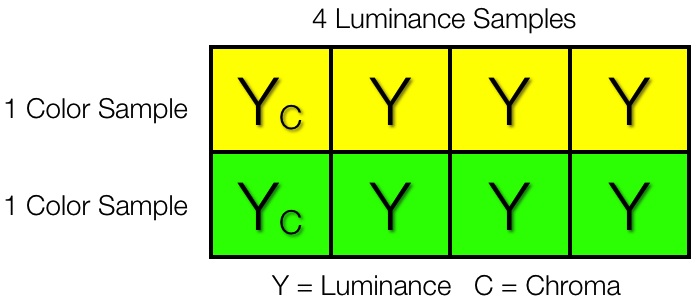
Again we still have full luminance information (the first '4'), but we have less chroma information, one on the first line and one on the second. This means that each chroma sampling is an average of 4 horizontal samples, which does not always give good results. With four horizontal samples averaged together, colors on the edges of your image can have a tendency to bleed. To fight this problem, most new compressions use 4:2:0 - 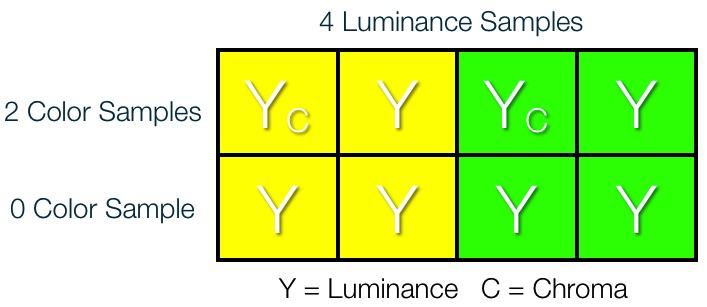
The luminance information is still kept at full resolution, but now we have two chroma samples on the first line and none on the second. Sounds bad, but really the chroma samples are an average of two horizontal pixels and two vertical pixels. This uses the same bit rate as a 4:1:1 compression, but without the same color bleeding issues. It is possible to have a 4:4:4 YCbCr image, but RGB is preferred for color correction. Color Sub-sampling cannot be done in the RGB color model, because each color channel also contains luminance information. We often see the term RGB 4:4:4, but it is actually a redundant use of the term. I guess that Sony and other manufactures figured it was better to be redundant then to have people confused.















